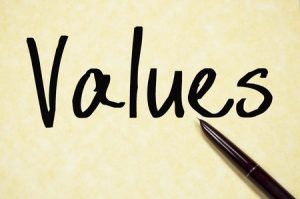A Look at the Few Critical Behaviors that Change Culture
A recent article in Strategy+Business, a publication by consulting firm PwC, highlighted 10 Principles of Organizational Change.
#3 caught my attention:
Focus on a critical few behaviors.
To improve an organization’s culture, the authors suggest its leaders focus on what they call “the critical few” a small number of important behaviors that will have the greatest impact, providing they are “put into practice by a significant number of people.”
To identify these “critical few” behaviors, the suggestion is made to identify the few things employees do that “positively affects business performance.” But there’s the rub. How do business leaders determine the elements that positively affect business performance? It is rarely obvious. I suspect this was an invitation for readers to ask for consulting help.
S+B Example
In the banking example described in the article, the authors reference three critical behaviors or values:
- Taking extra steps to delight customers.
- Valuing performance over seniority.
- Backing up and supporting one another.
While I was pleased they limited the list to three (which is very important), I see these as three of the 17 common values: Customers, Excellence, and Teamwork. While these are great values, I would propose they are NOT the “critical few” that “positively affects business performance.”
Instead of selecting from the list of common values, I recommend business leaders look for the two or three values that make a difference – what I call Differentiating Values. Here, I believe there is a way to identify the “critical few.” Using my values assessment, that includes a Values Test, leaders look for values that are unique (to the business), relevant (to key customers), and sustainable (over time).
Once these few differentiating values are selected, changing culture becomes a leadership issue.
Leaders Needed
 Before leaders can engage a significant portion of employees to practice these few critical values, they need to first be convinced that values matter.
Before leaders can engage a significant portion of employees to practice these few critical values, they need to first be convinced that values matter.
As I wrote in a previous article, leaders need to first see the benefits of having a few stated values, including:
- Values set strategic direction.
- Values define expected behavior (the key focus of the S+B article highlighted above).
- Values build competitive differentiation.
- Values empower leaders to simplify and focus.
The other issue leaders must contend with is aligning culture and values. As I wrote here, there are four key requirements:
- Recognize that everyone is impacted.
- People must be held accountable.
- There needs to be ongoing communication.
- Values need to be visible in the company’s marketing.
To change culture, employee behavior must be aligned with the organization’s key priorities. The best way to ensure everyone shares the same priorities is to have people who share the same values.
Frances Hesselbein, president and CEO of the Frances Hesselbein Leadership Institute, and former CEO of the Girl Scouts of the USA, may have stated it best:
“Culture does not change because we desire to change it. Culture changes when the organization is transformed; the culture reflects the realities of people working together every day.”










